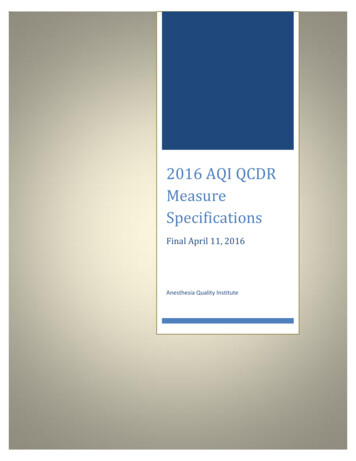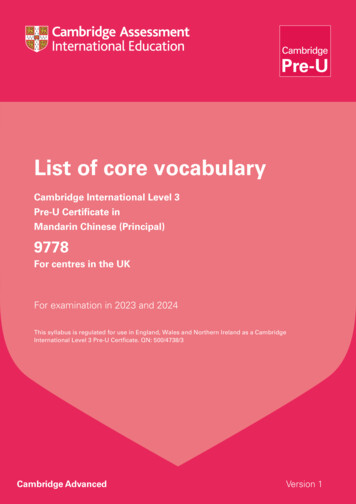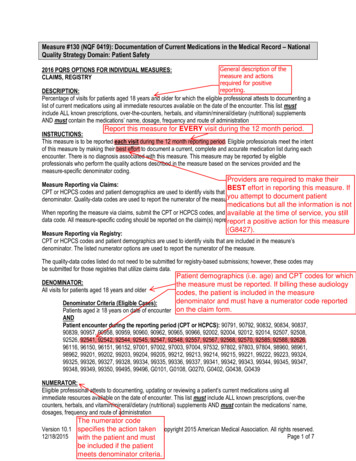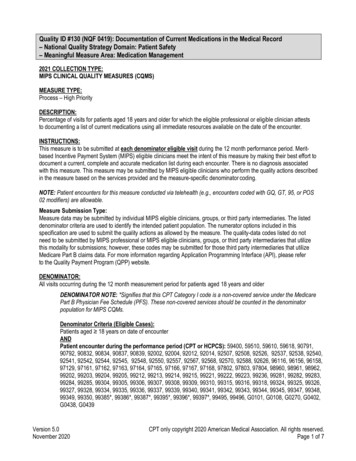
Transcription
2016 AQI QCDRMeasureSpecificationsFinal April 11, 2016Anesthesia Quality InstituteVersion
Table of ContentsINTRODUCTION TO 2016 SPECIFICATIONS .2MEASURES REMOVED FROM NON-PQRS ASA QCDR MEASURE SET .4MODIFICATIONS TO EXISTING NON-PQRS ASA QCDR MEASURES .7MEASURE(S) ADDED TO NON-PQRS ASA QCDR MEASURE LIST IN 2016 .8COPYRIGHT STATEMENT (ASA/AQI Measures) .9COPYRIGHT STATEMENT (Joint Copyright between ASA and the AMA-PCPI) . 10DEFINITIONS . 11*ASA #8 / AQI #3: Prevention of Post-Operative Vomiting (POV) - Combination Therapy (Pediatrics). 15ASA #10/ AQI #5: Composite Anesthesia Safety . 19ASA #13 / AQI #8: Post-anesthesia Care Unit (PACU) Re-intubation Rate . 23ASA #15 / AQI #10: Composite Procedural Safety for Central Line Placement . 26ASA #16 / AQI #11: Composite Patient Experience . 29ASA #23 / AQI #18: Coronary Artery Bypass Graft (CABG): Prolonged Intubation . 33ASA #38: New Corneal Injury Not Diagnosed in the Post-anesthesia Care Unit/Recovery Area after AnesthesiaCare . 36 2016 Anesthesia Quality Institute. All rights reserved. Please contact the Anesthesia Quality Institute ataskaqi@asahq.org for permission to use any of the information in this document. Updated April 11, 2016Page 1
INTRODUCTION TO 2016 SPECIFICATIONSThank you for your interest in reporting quality measures for the Physician Quality Reporting System (PQRS) viathe ASA Qualified Clinical Data Registry (ASA QCDR). This booklet includes measure specifications for thenon-PQRS measures contained in the ASA QCDR.The requirements for satisfactorily participating in a QCDR include:INDIVIDUAL REPORTING OPTION via ASA QCDROf the measures available via the ASA QCDR, report at least 9 measures covering at least 3 of the NQSdomains, AND report each measure for at least 50 percent of the EP’s patients. Of these measures, the EPwould report on at least 2 outcome measures, OR, if 2 outcomes measures are not available, report on atleast 1 outcome measures and at least 1 of the following types of measures – resource use, patientexperience of care, efficiency/appropriate use, or patient safety.1Eligible professionals (EPs) reporting at the individual level are assessed on an individual basis. Althoughthey may be part of a group practice, their PQRS assessment is based upon their individual performance.Note: ASA QCDR has not applied for Group Practice Reporting Option (GPRO) status for the QualifiedClinical Data Registry. Practices who seek to report via the GPRO function should contact a differentQCDR.For PQRS reporting, there are no hardship or low-volume exemptions. All EPs who furnish coveredprofessional services must participate in the PQRS program each year by meeting the criteria for satisfactoryreporting – for example, satisfactory participation in a QCDR, in order to avoid the PQRS payment adjustment.Individual EPs and practices are responsible for identifying a sufficient number of measures via the QCDR toreport throughout the year. This policy is consistent with other reporting mechanism as well. For the QCDRreporting option, you may use any combination of official PQRS measures and non-PQRS QCDR measuresavailable through the ASA QCDR reporting mechanism. For available PQRS measures, please consult the AQIwebsite.As required by regulation, practices will have access to their performance reports at least four times a year. It isthe responsibility of the individual EPs and/or practices to ensure that AQI is receiving all required data. Anyadjustments to collecting such data remain under the purview and responsibility of the individual EP and thepractice. If you have trouble accessing the reports or have questions on how to read the reports, please contactAQI at askaqi@asahq.org.Measure specifications are reviewed and updated on a yearly basis. It is the responsibility of the individual EPand/or the practice to make appropriate modifications to their data capture and reporting systems - on an annualbasis. Each year, ASA physician leaders, committees and staff review the measures for applicability to thepractice of anesthesiology, determine the feasibility of reporting such measures and take into considerationmeasure feedback received throughout the year. Practices and individual EPs are invited to attend virtual officehours for announcements and clarification on measures. Measure specifications as posted in this book are final forthe year 2016 and cannot be amended or changed by the practice for reporting purposes. If the practice cannotgather and submit all the specified denominator or quality-data codes in the numerator, the practice may notreport that measure. Questions related to reporting individual measures should be sent to qra@asahq.org.1The AQI offers more than two outcome measures to report. Therefore, EPs must report at least two outcome measures. 2016 Anesthesia Quality Institute. All rights reserved. Please contact the Anesthesia Quality Institute ataskaqi@asahq.org for permission to use any of the information in this document. Updated April 11, 2016Page 2
Note that the measure specifications include two different measure numbers – an “ASA XX” measure number andan “AQI XX” measure number. The ASA number has been used for several years in the ASA QCDR. The “AQIXX” number has been assigned by CMS. Gaps in numbering may reflect measures that have been removed fromthe ASA QCDR.PQRS measures that have been retired from the official PQRS measure list, such as Timely Administration ofProphylactic Antibiotics (formerly PQRS #30) and the Perioperative Temperature Management process measure(PQRS #193) are not available for reporting via the ASA QCDR.Participation in the ASA QCDR does not guarantee satisfactory participation in the PQRS program.Successful submission to CMS is contingent upon each individual EP and/or practice meeting the PQRSprogram requirements and the timeliness, quality, and accuracy of the data they provide for reporting. 2016 Anesthesia Quality Institute. All rights reserved. Please contact the Anesthesia Quality Institute ataskaqi@asahq.org for permission to use any of the information in this document. Updated April 11, 2016Page 3
MEASURES REMOVED FROM NON-PQRS ASA QCDR MEASURE SETPlease note that several previously used ASA QCDR measures have been placed in the official PQRS measureset. ASA has included these measures in the official PQRS measures available for reporting via the QCDRmechanism. Individual EPs and practices may choose to report any combination of PQRS and non-PQRS QCDRmeasures available through the ASA QCDR.2015 MeasureNumberASA #6 / PQRS #427Measure DescriptionPost-Anesthetic Transfer of Care: Use ofChecklist or Protocol for Direct Transfer ofCare from Procedure Room to Intensive CareUnit (ICU)Reason for Not Including in2016 SpecificationsMeasure has been adopted intoofficial PQRS list.Measure is available for reportingvia the ASA QCDR and ASAQualified Registry mechanism.Measure has been adopted intoofficial PQRS list.ASA #7 / PQRS #430Prevention of Post-Operative Nausea andVomiting (PONV)Measure is available for reportingvia the ASA QCDR and ASAQualified Registry mechanism.Measure has been adopted intoofficial PQRS list.ASA #9 / PQRS #426Anesthesiology: Post-Anesthetic Transfer ofCare Measure: Procedure Room to a PostAnesthesia Care UnitASA #11Perioperative Cardiac ArrestMeasure was not accepted byCMS for 2016.ASA #12Perioperative Mortality RateMeasure was not accepted byCMS for 2016.ASA #14Assessment of Acute Postoperative PainMeasure was not accepted byCMS for 2016.ASA #17 / PQRS #30Perioperative Care: Timely Administration ofProphylactic Parenteral AntibioticsMeasure has been retired fromofficial PQRS list.Measure is available for reportingvia the ASA QCDR and ASAQualified Registry mechanism. 2016 Anesthesia Quality Institute. All rights reserved. Please contact the Anesthesia Quality Institute ataskaqi@asahq.org for permission to use any of the information in this document. Updated April 11, 2016Page 4
2015 MeasureNumberMeasure DescriptionPerioperative Temperature ManagementASA #18 / PQRS #424Reason for Not Including in2016 SpecificationsMeasure has been adopted intoofficial PQRS list.NOTE: For 2016, CMS has identified thismeasure as a process measure.Measure is available for reportingvia the ASA QCDR and ASAQualified Registry mechanism.ASA #19Perioperative Use of Aspirin for patients withDrug-eluting Coronary StentsMeasure was not accepted byCMS for 2016.ASA #20Surgical Safety Checklist – Applicable SafetyChecks Completed Before Induction ofAnesthesiaMeasure was not accepted byCMS for 2016.Measure has been adopted intoofficial PQRS list.ASA #21 / PQRS #404Smoking AbstinenceASA #22Corneal Injury Diagnosed in the PostAnesthesia Care Unit/Recovery Area afterAnesthesia Care (Inverse Measure)Measure was changed from aninverse measure to atraditional/positive performancemeasure. New measure is nowidentified as ASA #38.ASA #24Coronary Artery Bypass Graft (CABG): StrokeMeasure was not accepted byCMS for 2016.ASA #25Coronary Artery Bypass Graft (CABG): PostOperative Renal FailureMeasure was not accepted byCMS for 2016.Measure is available for reportingvia the ASA QCDR and ASAQualified Registry mechanism. 2016 Anesthesia Quality Institute. All rights reserved. Please contact the Anesthesia Quality Institute ataskaqi@asahq.org for permission to use any of the information in this document. Updated April 11, 2016Page 5
2015 MeasureNumberASA #28ASA #30ASA #31Measure DescriptionRate of Post-Operative stroke or death inasymptomatic patients undergoing CarotidEndarterectomy (CAE)Rate of Endovascular aneurysm repair (EVAR)of small or moderate non-ruptured abdominalaortic aneurysm (AAA) who die while in thehospitalTotal Knee Replacement: VenousThromboembolic and Cardiovascular RiskEvaluationReason for Not Including in2016 SpecificationsMeasure was not accepted byCMS for 2016.Measure was not accepted byCMS for 2016.Measure was not accepted byCMS for 2016.ASA #32Total Knee Replacement: PreoperativeAntibiotic Infusion with Proximal TourniquetMeasure was not accepted byCMS for 2016.ASA #33Unplanned Hospital Readmission within 30days of Principal ProcedureMeasure was removed forfeasibility issues.ASA #34Surgical Site InfectionMeasure was removed forfeasibility issues. 2016 Anesthesia Quality Institute. All rights reserved. Please contact the Anesthesia Quality Institute ataskaqi@asahq.org for permission to use any of the information in this document. Updated April 11, 2016Page 6
MODIFICATIONS TO EXISTING NON-PQRS ASA QCDR MEASURESThe table below identifies changes that were made to the ASA non-PQRS QCDR measures available in 2015 inpreparation for 2016. This table only serves as general reference in support of but not superseding the finalmeasure specifications for each measure within the booklet.2015 MeasureNumberMeasure TitleASA #8 / AQI #3Prevention of Post-Operative Vomiting (POV)- Combination Therapy (Pediatrics)ASA #10 / AQI #5Composite Anesthesia SafetyASA #13 / AQI #8Post-anesthesia Care Unit (PACU) ReIntubation RateASA #15 / AQI #10Composite Procedural Safety for Central LinePlacementASA #16 / AQI #11Composite Patient ExperienceASA #23 / AQI #18Coronary Artery Bypass Graft (CABG):Prolonged IntubationModifications Denominator Exclusion Added Denominator Criteria Updated(Removed CPT Codes 00326,00561, 00834, 00836) Measure Description Updated Denominator Exclusion Added Denominator Criteria Updated(Added CPT Codes 01953,01967) Denominator Definition Added Denominator Exclusion Added Denominator Criteria Updated(Removed CPT Codes 01967,01990, 01999, ASA13F) Denominator Criteria Updated(Added ASA13H, ASA13J) Measure Description Updated Denominator Definition Added Denominator Exclusion Added Denominator Criteria Updated(Removed CPT Codes 75901,75902) Performance Exclusion Deleted Rationale Updated Denominator Criteria Updated(Removed CPT Codes 00326,00561, 00834, 00836, 01990,01999) Denominator Criteria Updated(Added CPT Codes 01953,01967, 01968, 01969) Denominator Exclusion Added Performance Not Met Updated Rationale Updated No Changes 2016 Anesthesia Quality Institute. All rights reserved. Please contact the Anesthesia Quality Institute ataskaqi@asahq.org for permission to use any of the information in this document. Updated April 11, 2016Page 7
MEASURE(S) ADDED TO NON-PQRS ASA QCDR MEASURE LIST IN 20162016 MeasureNumberASA #38 / AQI TBDMeasure DescriptionNew Corneal Injury Not Diagnosed in the PostAnesthesia Care Unit/Recovery Area afterAnesthesia CareMeasure ProvenanceAmerican Society ofAnesthesiologists 2016 Anesthesia Quality Institute. All rights reserved. Please contact the Anesthesia Quality Institute ataskaqi@asahq.org for permission to use any of the information in this document. Updated April 11, 2016Page 8
COPYRIGHT STATEMENT (ASA/AQI Measures)These performance measures (Measures) are not clinical guidelines, do not establish a standard of medical care,and have not been tested for all potential applicants. The American Society of Anesthesiologists (ASA), and itsrelated organization, the Anesthesia Quality Institute (AQI), shall not be responsible for any use of the Measures.The Measures, while copyrighted, can be reproduced and distributed, without modification, for non-commercialpurposes, e.g., use by health care providers in connection with their practices.Commercial use is defined as the sale, license, or distribution of the Measures for commercial gain, orincorporation of the Measures into a product or service that is sold, licensed or distributed for commercial gain.ASA and AQI encourage use of the Measures by other health care professionals, where appropriate.Please contact the Anesthesia Quality Institute at askaqi@asahq.org before using information contained in thisdocument to ensure proper permissions are obtained.Limited proprietary coding is contained in the Measure specifications for convenience. Users of the proprietarycode sets should obtain all necessary licenses from the owners of these code sets. ASA and AQI disclaim allliability for use or accuracy of any Current Procedural Terminology (CPT ) or other coding contained in thespecifications.THE MEASURES AND SPECIFICATIONS ARE PROVIDED “AS IS” WITHOUT WARRANTY OF ANYKIND. 2016 Anesthesia Quality Institute. All rights reserved. Please contact the Anesthesia Quality Institute ataskaqi@asahq.org for permission to use any of the information in this document. Updated April 11, 2016Page 9
COPYRIGHT STATEMENT (Joint Copyright between ASA and the AMA-PCPI)* The following notice (in addition to the notice on the previous page) applies to each of the Measures thatcontains an asterisk (*) within its title.Commercial uses of the Measures require a license agreement between the user and the PCPI Foundation(PCPI ) or ASA. Neither ASA, nor the American Medical Association (AMA), nor the AMA-convenedPhysician Consortium for Performance Improvement (AMA-PCPI), now known as the PCPI, nor their membersshall be responsible for any use of the Measures.The AMA’s and AMA-PCPI’s significant past efforts and contributions to the development and updatingof the Measures is acknowledged. ASA is solely responsible for the review and enhancement(“Maintenance”) of the Measures as of July 10, 2014.Limited proprietary coding is contained in the Measure specifications for convenience. Users of the proprietarycode sets should obtain all necessary licenses from the owners of these code sets. ASA, the AMA, the PCPI andits members and former members of the AMA-PCPI disclaim all liability for use or accuracy of any CurrentProcedural Terminology (CPT ) or other coding contained in the specifications.CPT contained in the Measures specifications is copyright 2004-2015 American Medical Association. LOINC copyright 2004-2015 Regenstrief Institute, Inc. SNOMED CLINICAL TERMS (SNOMED CT ) copyright2004-2015 The International Health Terminology Standards Development Organization (IHTSDO). ICD-10 iscopyright 2015 World Health Organization. All Rights Reserved. 2016 American Medical Association and American Society of Anesthesiologists. All Rights Reserved.Applicable FARS/DFARS Restrictions Apply to Government Use. 2016 Anesthesia Quality Institute. All rights reserved. Please contact the Anesthesia Quality Institute ataskaqi@asahq.org for permission to use any of the information in this document. Updated April 11, 2016Page 10
DEFINITIONS2Continuous Score: A measure score in which each individual value for the measure can fall anywhere along acontinuous scale, and can be aggregated using a variety of methods such as the calculation of a mean or median(for example, mean number of minutes between presentation of chest pain to the time of administration ofthrombolytics). NOTE: The ASA QCDR does not include any continuous score measures for 2016.CPT Category II Codes: CPT Category II or CPT II codes, developed through the CPT Editorial Panel for usein performance measurement, encode the clinical action(s) described in a measure’s numerator. CPT II codesconsist of five alphanumeric characters in a string ending with the letter “F.” CPT II codes are not modified orupdated during the reporting period and remain valid for the entire program year as published in the measurespecifications manuals and related documents for PQRS.CPT II Modifiers: CPT II modifiers are unique to CPT II codes and may be used to report measures byappending the appropriate modifier to a CPT II code as specified for a given measure. The modifiers for a codecannot be combined and their use is guided by the measure’s coding instructions, which are included in thenumerator coding section of the measure specifications. Use of the modifiers is unique to CPT II codes and maynot be used with other types of CPT codes. Only CPT II modifiers may be appended to CPT II codes.Descriptions of each modifier are provided below to help identify circumstances when the use of a modifier maybe appropriate. Note that reporting an exclusion or reporting modifier will alter an EP’s performance rate.Accurate reporting on all selected measures will count toward the reporting requirements, whether the clinicalaction is reported as complete or not complete (or performance met or not met). CPT II code modifiers fall into two categories; exclusion modifiers and the 8P reporting modifier.Exclusion modifiers may be appended to a CPT II code to indicate that an action specified in the measurewas not provided due to medical, patient, or system reason(s) documented in the medical record. Thesemodifiers serve as denominator exclusions for the purpose of measuring performance. Not all exclusionswill apply to every measure, and some measures do not allow any performance exclusions.Denominator (Eligible Cases): The lower part of a fraction used to calculate a rate, proportion, or ratio. It canbe the same as the initial population or a subset of the initial population to further constrain the population for thepurpose of the measure.Denominator exception: Those conditions that should remove a patient, procedure, or unit of measurement fromthe denominator of the performance rate only if the numerator criteria are not met. Denominator exceptions allowfor adjustment of the calculated score for those providers with higher risk populations. Denominator exceptionsare used only in proportion measures. Denominator exceptions allow for the exercise of clinical judgment andshould be specifically defined where capturing the information in a structured manner fits the clinical workflow.These cases are removed from the denominator; however the number of patients with valid exceptions may stillbe reported. Exceptions allow for the exercise of clinical judgment. Allowable reasons fall into three generalcategories: Medical reasons Patient reasons System reasons2ASA and AQI have gathered these definitions from a number of sources including, but not limited to, CMS PQRSImplementation Guide, CMS Measure Blueprint and other official CMS documents, the National Quality Forum PhraseBook, ASA reference documents and other materials. For specific references, please contact the ASA Department of Qualityand Regulatory Affairs (QRA) at qra@asahq.org. 2016 Anesthesia Quality Institute. All rights reserved. Please contact the Anesthesia Quality Institute ataskaqi@asahq.org for permission to use any of the information in this document. Updated April 11, 2016Page 11
Denominator Exclusion: Patients who should be removed from the measure population and denominator beforedetermining if numerator criteria are met. Denominator exclusions are used in proportion and ratio measures tohelp narrow the denominator. (For example, patients with bilateral lower extremity amputations would be listed asa denominator exclusion for a measure requiring foot exams.)Denominator statement: A statement that describes the population evaluated by the performance measure.eCQM: Electronic clinical quality measures (eCQMs) are standardized performance measures derived solely foruse in EHRs. NOTE: The ASA QCDR does not include any eCQMs for 2016.Eligible Professionals (EPs): Healthcare professionals who are providing services which get paid under or arebased on the Medicare Physician Fee Schedule.G-codes for PQRS: A set of Centers for Medicare & Medicaid Services (CMS)-defined temporary HealthcareCommon Procedure Coding System (HCPCS codes) used to report quality measures on a claim. G-codes aremaintained by CMS.Initial (patient) population: Refers to all events to be evaluated by a specific performance eMeasure involvingpatients who share a common set of specified characteristics within a specific measurement set to which a givenmeasure belongs. All patients counted (for example, as numerator, as denominator) are drawn from the initialpopulation.Intermediate Outcome Measure: An intermediate outcome measure assesses a factor or short-term result thatcontributes to an ultimate outcome.Inverse Measure: An inverse measure is a measure that represents a poor clinical quality action as meetingperformance for the measure. For this measure, a lower performance rate indicates a higher quality of clinicalcare.NACOR (National Anesthesia Clinical Outcomes Registry): A data warehouse that has been designated as aQualified Clinical Data Registry (QCDR) by the Centers for Medicare and Medicaid Services (CMS) forPhysician Quality Reporting System (PQRS) reporting.National Quality Strategy (NQS): The National Quality Strategy was first published in March 2011 asthe National Strategy for Quality Improvement in Health Care, and is led by the Agency for Healthcare Researchand Quality on behalf of the U.S. Department of Health and Human Services (HHS).Mandated by the Patient Protection and Affordable Care Act, the National Quality Strategy was developedthrough a transparent and collaborative process with input from a range of stakeholders. More than 300 groups,organizations, and individuals, representing all sectors of the health care industry and the general public, providedcomments. Based on this input, the National Quality Strategy established a set of three overarching aims thatbuilds on the Institute for Healthcare Improvement's Triple Aim , supported by six priorities that address themost common health concerns that Americans face. To align with National Quality Strategy, stakeholders can usenine levers to align their core business or organizational functions to drive improvement on the aims andpriorities.To advance these aims, the National Quality Strategy focuses on six priorities (domains): Making care safer by reducing harm caused in the delivery of care. Ensuring that each person and family is engaged as partners in their care. Promoting effective communication and coordination of care. 2016 Anesthesia Quality Institute. All rights reserved. Please contact the Anesthesia Quality Institute ataskaqi@asahq.org for permission to use any of the information in this document. Updated April 11, 2016Page 12
Promoting the most effective prevention and treatment practices for the leading causes of mortality,starting with cardiovascular disease.Working with communities to promote wide use of best practices to enable healthy living.Making quality care more affordable for individuals, families, employers, and governments by developingand spreading new health care delivery models.Measure: A mechanism to assign a quantity to an attribute by comparison to a criterion. A measure may standalone or belong to a composite, subset, set, and/or collection of measures. A healthcare performance measure is away to calculate whether and how often the healthcare system does what it should. Measures are based onscientific evidence about processes, outcomes, perceptions, or systems that relate to high-quality care. See CMSMeasure Blueprint.Numerator: The upper portion of a fraction used to calculate a rate, proportion, or ratio. Also called the measurefocus, it is the target process, condition, event, or outcome. Numerator criteria are the processes or outcomesexpected for each patient, procedure, or other unit of measurement defined in the denominator. A numeratorstatement describes the clinical action that satisfies the conditions of the performance measure.Numerator exclusions: Patients who are included in the initial patient population, who do not meet the measurenumerator criteria, but who do meet the specific numerator exclusionary criteria. Numerator exclusions are notconsidered to be part of a given measure’s numerator.Outcome Measure: A measure that assesses the results of healthcare that are experienced by patients: clinicalevents, recovery and health status, experiences in the health system, and efficiency/cost. See CMS MeasureBlueprint.Performance Measure Reporting Modifier: The 8P reporting modifier is intended to be used as a “reportingmodifier” to allow the reporting of circumstances when an action described in a measure’s numerator is notperformed and the reason is not otherwise specified.Performance Timeframe: A designated timeframe within which the action described in a performance measureshould be completed. This timeframe is generally included in the measure description and may or may notcoincide with the measure’s data reporting frequency requirement.Physician Quality Reporting System (PQRS): The Physician Quality Reporting System (PQRS) is a qualityreporting program that encourages individual eligible professionals (EPs) and group practices to reportinformation on the quality of care to Medicare. PQRS gives participating EPs and group practices the opportunityto assess the quality of care they provide to their patients, helping to ensure that patients get the right care at theright time.Process Measure: A measure that focuses on steps that should be followed to provide good care. There shouldbe a scientific basis for believing that the process, when executed well, will increase the probability of achieving adesired outcome. See CMS Measure Blueprint.Proportion Measure: A score derived by dividing the number of cases that meet a criterion for quality (thenumerator) by the number of eligible cases within a given time frame (the denominator) where the numeratorcases are a subset of the denominator cases (for example, percentage of eligible women with a mammogramperformed in the last year).Qualified Clinical Data Registry (QCDR): A CMS-approved entity that collects medical and/or clinical datafor the purpose of patient and disease tracking to foster improvement in the quality of care provided to patients. A 2016 Anesthesia Quality Institute. All rights reserved. Please contact the Anesthesia Quality Institute ataskaqi@asahq.org for permission to use any of the information in this document. Updated April 11, 2016Page 13
QCDR will complete the collection and submission of PQRS quality measures data on behalf of individualeligible professionals (EPs).Quality: Quality is how good something is. For healthcare, it is often expressed in a range. When a personreceives high-quality healthcare, he or she has received the right services, at the right time, and in the right way toachieve the best possible health. See NQF Phrase Book.Quality-Data Codes: QDCs are non-payable Healthcare Common Procedure Coding System (HCPCS) codescomposed of specified CPT Category II codes and/or G-codes that describe the clinical action required by ameasure’s numerator. Clinical actions can apply to more than one condition and, therefore, can also apply to morethan one measure. Where necessary, to avoid shared CPT Category II codes, G-codes are used to distinguishclinical actions across measures. Some measures require more than one clinical action and may have more thanone CPT Category II code, G-code, or a combination associated with them. EPs should review numeratorreporting instructions for each measure carefully.Quality Improvement: Quality improvement (QI) encompasses all of the
Version 2016 AQI QCDR Measure Specifications Final April 11, 2016 Anesthesia Quality Institute










